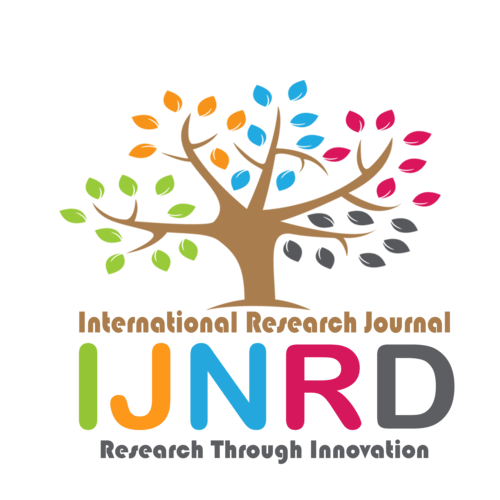|
|||||||||||||||

|
INTERNATIONAL JOURNAL OF NOVEL RESEARCH AND DEVELOPMENT International Peer Reviewed & Refereed Journals, Open Access Journal ISSN Approved Journal No: 2456-4184 | Impact factor: 8.76 | ESTD Year: 2016 Scholarly open access journals, Peer-reviewed, and Refereed Journals, Impact factor 8.76 (Calculate by google scholar and Semantic Scholar | AI-Powered Research Tool) , Multidisciplinary, Monthly, Indexing in all major database & Metadata, Citation Generator, Digital Object Identifier(DOI) |
||||||||||||||
Issue: May 2024
Volume 9 | Issue 5
Review Result and Publication of Paper within : 2-3 days
Click Here For more DetailsFor Authors
Forms / Download
Published Issue Details
Editorial Board
Other IMP Links
Facts & Figure
Impact Factor : 8.76
Issue per Year : 12
Volume Published : 9
Issue Published : 96
Article Submitted :
Article Published :
Total Authors :
Total Reviewer :
Total Countries :
Indexing Partner
Join RMS/Earn 300
Licence
This work is licensed under a Creative Commons Attribution-NonCommercial 4.0 International License







|
Published Paper Details
|
|
| Paper Title: | Effect of Light intensities on the growth of Fungal plant pathogen Alternaria solani, and Initiation of Leaf spot Disease symptoms in Tomato Plants: A New Study |
| Authors Name: | S. G. Borkar , Priyanka. B. Kadam , Ajayasree. T.S |
| Download E-Certificate: | Download |
| Author Reg. ID: |
IJNRD_213723
|
| Published Paper Id: | IJNRD2402253 |
| Published In: | Volume 9 Issue 2, February-2024 |
| DOI: | |
| Abstract: | The natural visible lights emitted by the sun and moon are a driving force for life on our planet. Though life begins in the dark, both darkness and sunlight illumination are necessarily required for the life processes and several metabolic cycles in living beings. This light illumination in terms of light intensities varies in the day, months of the year, and at a given latitude and longitude of a location on planet Earth. Its role in the growth of plant pathogenic fungi and plant disease initiation has not yet been studied and reported. In the present investigation, we studied the effect of light intensities on the growth of fungal plant pathogen Alternaria solani under in vitro conditions and its effect on initiation of leaf spot disease symptoms in tomato plants. Further, the sunlight and moonlight intensities at locations having 19.392677 latitude and 74.648827 longitude in India were measured in the agricultural field and in tomato plant canopies to relate these with A. solani leaf spot disease development. The natural light intensities were measured in lux (Lx) units with the help of a photometric Lux meter during three agricultural crop seasons of a year (rainy season: June – September; winter season: October – January, and summer season: February – May). The natural sunlight intensities varied during the day and months over this period. The sunlight intensities of 72,000 – 1, 08, 100 received from 12.00-2.00 pm and 45, 000 – 1, 05, 200 Lx received from 2.00- 4.00 pm have a detrimental effect on the growth of a tomato leaf spot fungal pathogen Alternaria solani. The light intensities lower than 72, 000 Lx were favourable for the growth of this fungal pathogen. The lunar light intensities were observed very negligible i.e. 0.1 to 0.7 Lx during the full-moon nights, otherwise, these were 0.0 Lx during other nights. The effect of lunar light intensities on the growth of this fungal pathogen was negligible as compared to total darkness which produced more fungal growth. The diurnal treatment of 6 hours of light + 18 hours of darkness produced more fungal growth of A. solani as compared to continuous light without any dark period. To initiate Alternaria leaf spot disease symptoms in tomato plant leaves, the lower light intensities up to 2000 Lx were much more helpful than the higher light intensities under in vitro studies. Such lower light intensities were available in the lower-leaf canopies of the tomato plants under field conditions, which may be one of the reasons for the first initiation and development of Alternaria leaf spot and blight symptoms in lower leaves of tomato plants. The minimum light intensity of 180 Lx and 420 Lx was observed in the rainy and winter seasons respectively while the minimum light intensity of 3200 Lx was observed in the summer season. The varied light intensities in different months may be the reason for the prevalence of this fungus prominently during particular periods of the months of the year. These results of light intensities are useful to determine the structure of the shade-net or poly-houses, which can regulate the light intensities in the protected cultivations to hamper fungal growth and disease development by this pathogen. |
| Keywords: | Light intensities, Sunlight, Moonlight, Lux unit, fungal growth, Alternaria solani, disease development, tomato crop, protected cultivation. |
| Cite Article: | "Effect of Light intensities on the growth of Fungal plant pathogen Alternaria solani, and Initiation of Leaf spot Disease symptoms in Tomato Plants: A New Study ", International Journal of Novel Research and Development (www.ijnrd.org), ISSN:2456-4184, Vol.9, Issue 2, page no.c458-c472, February-2024, Available :http://www.ijnrd.org/papers/IJNRD2402253.pdf |
| Downloads: | 000118768 |
| ISSN: |
2456-4184 | IMPACT FACTOR: 8.76 Calculated By Google Scholar| ESTD YEAR: 2016 An International Scholarly Open Access Journal, Peer-Reviewed, Refereed Journal Impact Factor 8.76 Calculate by Google Scholar and Semantic Scholar | AI-Powered Research Tool, Multidisciplinary, Monthly, Multilanguage Journal Indexing in All Major Database & Metadata, Citation Generator |
| Publication Details: |
Published Paper ID:IJNRD2402253 Registration ID: 213723 Published In: Volume 9 Issue 2, February-2024 DOI (Digital Object Identifier): Page No: c458-c472 Country: -, -, India Research Area: Engineering Publisher : IJ Publication Published Paper URL : https://www.ijnrd.org/viewpaperforall?paper=IJNRD2402253 Published Paper PDF: https://www.ijnrd.org/papers/IJNRD2402253 |
| Share Article: | |
|
Click Here to Download This Article |
|
| Article Preview | |
|
|
|
Major Indexing from www.ijnrd.org
| Semantic Scholar | Microsaoft Academic | ORCID | Zenodo |
| Google Scholar | ResearcherID Thomson Reuters | Mendeley : reference manager | Academia.edu |
| arXiv.org : cornell university library | Research Gate | CiteSeerX | PUBLON |
| DRJI | SSRN | Scribd | DocStoc |
ISSN Details
 |
 |
ISSN: 2456-4184
Impact Factor: 8.76 and ISSN APPROVED
Journal Starting Year (ESTD) : 2016
DOI (A digital object identifier)
Conference
Open Access License Policy
Important Details
Social Media
| Copyright © 2024 - All Rights Reserved - IJNRD |












Facebook Twitter Instagram LinkedIn